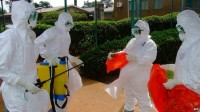 Thanks
very much for keeping your compatriots informed about the Ebola
epidemic. We expected such from Ministries of Health and Sanitation and
Information and Broadcasting at the unset of the outbreak.
Thanks
very much for keeping your compatriots informed about the Ebola
epidemic. We expected such from Ministries of Health and Sanitation and
Information and Broadcasting at the unset of the outbreak. Meanwhile, while your daily update is keeping us abreast with OFFICIAL figures, it’s still leaving us with many unanswered questions regarding the killer disease. We know that you are assigned at the head office of the Ministry of Health and Sanitation in Freetown and could not go all over the country to crosscheck information. But now that you are serving as source of information regarding Ebola, we expect you to know more than everyone. The epidemic has claimed many innocent lives including poorly trained and less-informed personnel who tried to stop it at the initial stage. Your daily update is not showing any sign of reduction regardless the fact that the figures are (very) OFFICIAL. Which means we shouldn’t be only taking your OFFICIAL figures for granted but rather go deeper into analysing the causes of and preventive measures to Ebola. So Mr. Tunis, can you please help us to answer the following questions:
What kind of preventive measures are we using?
When Ebola broke out in neighbouring Guinea, our government claimed to be well prepared ahead of any eventuality. Can you please tell us what was the preventive measure put in place by your ministry at that time? Knowing fully well that Ebola could rapidly spread if the victims are not isolated/quarantined, what kind of preventive measures the government was following by transporting the patients from one place to another – from Kailahun down to Kenema? Your laboratory test results are released a day or two later, which means there is no on-the-site test technic. We know that Ebola has symptoms which are typical for malaria, cholera and other viral hemorrhagic fever. So what specific symptom are your medical personnel checking for at roadblocks such as Bandama? We are told that the sporadic test of passengers at those roadblocks basically aims at weeding out people with higher temperatures, which is also a true symptom of malaria, hypertension etc. This technically tells that you may have quarantined many non-ebola patients.
Don’t you think 1 (true) Ebola patient quarantined together with 10 malaria and hypertensive patients could change the figure (infect the others) unintentionally? That brings me to the question: how are they quarantined? Are the quarantine booths partitioned?
Your updates mentioned that you have discharged quite a few patients who you believe were earlier tested positive (perhaps of malaria, who knows?). What is the message are you telling the discharged patients – particularly the men? Do they know that Ebola can be transmitted sexually and men who survived it could transmit it for nearly two months?
How many people in Kailahun and Kenema are aware of the following measures?
Wash your hands frequently.
As with other infectious diseases, one of the most important preventive
measures for Ebola virus is frequent hand-washing. Use soap and water,
or use alcohol-based hand rubs containing at least 60 percent alcohol
when soap and water aren't available.
Avoid bush meat. In
Sierra Leone, wild animals, including nonhuman primates, are sold in
local markets. Avoid buying or eating any of these animals.
Avoid contact with infected people.
In particular, caregivers should avoid contact with the person's body
fluids and tissues, including blood, semen, vaginal secretions and
saliva. People with Ebola are most contagious in the later stages of the
disease.
Follow infection-control procedures.
If you're a health care worker, wear protective clothing — such as
gloves, masks, gowns and eye shields. Keep infected people isolated from
others. Carefully disinfect and dispose of needles and other
instruments. Injection needles and syringes should not be reused.
Don't handle remains.
It’s religious, cultural and traditional to wash bodies in Sierra Leone
before buried. The bodies of people who have died of Ebola or are still
contagious. Specially organized and trained teams should bury the
remains, using appropriate safety equipment.
How transparent is the fight against Ebola?A press release from State House on 3rd July informed us that President Koroma and his cabinet ministers and their deputies have decided to donate part of their salaries to the consolidated fund to fight against Ebola. Ministers are to donate 50% and deputies 25% of their salaries for July. If the release is not intended to distract public attention from the lacklustre and unprofessional manner the government has handled the Ebola epidemic, the Accountant General must have been ordered to pay the ministers and their deputies (NOW) so that the fund could be used against Ebola. We would like to know what is the exact figure in that account now?
Some private citizens are responding to President Kaoroma’s though late but wake up call to fight Ebola. Foreign partners are also pumping in with medical supplies, personnel and physical money.
There is the ongoing vuvuzilla noise that the government has donated millions, if not billion, to fight Ebola in Kailahun. The ordinary citizen would like to know what is the actual breakdown of that fund? Who paid what and when? We know that there is no vaccine or specific cure for Ebola, the patients can be only helped with either oral rehydration therapy or intravenous fluids. Medical personnel deployed across the region are either aid agents or government employees, which means none is paid from the donation funds. The above triggers the questions: what is specifically being done with the donated funds? Who is administering it?
In anticipation of your clear response to the above questions, I wish to take this opportunity to that you and colleagues for the tireless fight against the most dangerous disease in our life time.
Kind regards